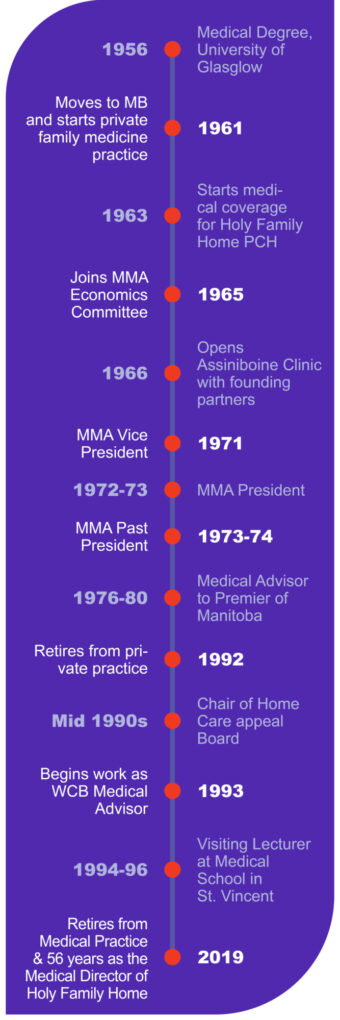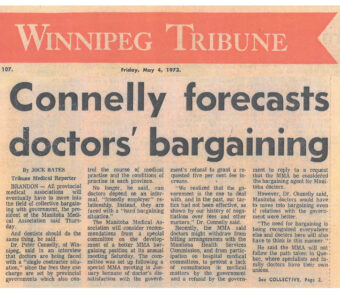The Formative Years
A Discussion with Dr. Peter Connelly, President (1972−73)
By Keir Johnson
Consider a list of the top issues in medicine right now. The need for strategies to recruit physicians to rural and Northern communities. Tensions with governments about how physicians are funded or how much they are funded. The need for more consultation with doctors about changes in health care.
Believe it or not, many of these same issues were top of mind half a century ago, when Dr. Peter Connelly was President of the Manitoba
Medical Association, today called Doctors Manitoba. This was an exciting period for the profession and the MMA, as universal, publicly insured medical care was just being established.
Doctors Manitoba sat down with Dr. Connelly, who is now 92 years old, to hear about his time as President, his reflections on how the profession has since evolved, and his concerns about the issues doctors are facing today.

A Pivotal Period
Dr. Connelly served as President in 1972 and 1973. This was a pivotal period for the medical profession.
Just a couple of years earlier in 1969, Manitoba signed on to the federal plan to offer comprehensive, universal, publicly insured medical care. Soon after, the government also produced a White Paper on Health Policy, which envisioned replacing independent physician practices with government-run community clinics.
This was part of the agenda for the new government elected that year, led by Premier Ed Schreyer.
“You saw this agenda coming at us,” explains Dr. Connelly. “We had to respond.” Physicians were concerned by the government’s approach to introducing this new public insurance, and the lack of consultation with doctors about significant health policy decisions that would affect how they cared for their patients.
At the outset of medicare, the provincial government unilaterally assigned a fee schedule for physician services, which then remained frozen.
Meanwhile, costs were increasing, and doctors were facing economic challenges, on top of uncertainty about what broader changes to the health system the government would make.
Doctors needed someone to represent them with the government.
The MMA needed to evolve.
In response to the government’s White Paper, the MMA produced a Green Paper with a clear medically-informed vision for medical care.
Dr. Connelly explained in a newspaper interview at the time that “the need for bargaining is being recognized everywhere else and doctors here will also have to think in this manner.”
Dr. Connelly was President at the right time. Described as a “tough-talking” leader by a local news editorialist, he brought needed expertise from his years on the MMA’s Economics Committee, as well as business and negotiations acumen as a founding partner of Assiniboine Clinic.
An MMA news release that year described the issues. “Major complaints by the MMA are that the provincial government and its agencies have adopted a master-servant attitude toward the Medical Profession, pay no attention to what doctors have to say on health policies, and have stalled any cost-of-living adjustment in medical fees.”
In response to the government’s unilateral actions, Dr. Connelly and the MMA meaningfully engaged members regularly during this period. They sought out physician views on both the economic and health policy issues that were of top concern. A response to the government’s clinic plan was developed. Members approved a resolution to “examine all possibilities for transforming this Association into an effective bargaining agency for its members.”
Suddenly, the MMA and its President were routinely in the news. There were dozens of tense meetings with government officials. Issues were escalated to the Minister of Health, and later to the Premier. But what started as a very confrontational relationship with government, eventually evolved.
“Mr. Schreyer actually came for lunch at my house, and then I was eventually invited to present to the entire provincial cabinet,” recalls Dr. Connelly.
In the end, after a lengthy period of public and political advocacy, physicians prevailed.
The MMA was recognized as the bargaining agent for physicians.
In 1974, with Dr. Connelly now serving as Past-President, the government announced a two-year deal had been reached with the MMA to not only offer a substantial fee increase to physicians, but also to create a formal consultative committee “charged with developing ongoing co-operation and understanding between the commission and the association.”
Looking back fifty years later, Dr. Connelly describes this as a major achievement. “We negotiated a whole new structure to fund physicians. This was the beginning. This was the foundation.”

The Power of Unity
In the face of conflict and potential divisiveness over how physician care would be funded and how the MMA would support physicians, the profession came together. Meetings during this period were well-attended, with up to a third of all physicians in the province participating.
For example, the 1973 Annual General Meeting was attended by over 400, with members asked to give the MMA clear direction to represent the profession with government. The Winnipeg Free Press covered the important meeting and concluded “the Manitoba Medical Association gathered its members Saturday in search of unity for collective bargaining sessions with medicare and received both the negotiating muscle it sought and a unanimous mandate to flex it during the weeks to come.”
Dr. Connelly said at the time, “The MMA will not follow the path taken in Quebec, where specialists and family doctors have their own unions.”1 Indeed, he had stressed the value of physician unity to members through the entire process.
Another way the MMA sought to maintain unity was by engaging members often in the challenges the profession was facing, and ensuring the Board reflected the professional and geographic diversity of its members.

Looking Back and Looking Forward
Dr. Connelly grew up in Scotland. After serving with Army Intelligence, he obtained his medical degree from University of Glasgow in 1956. After practicing for a few years, he moved to Manitoba in 1961 with his wife and two small children.
“A doctor friend of mine thought I could come to Manitoba, and I thought ok, why not?”
He worked as a family physician in primary care and in the hospital. Dr. Connelly was one of the original physicians involved in establishing Assiniboine Clinic in 1966, which today is one of the largest clinics in Manitoba. “We built the clinic there to be right by the new Grace Hospital,” he explains. “At that time, all the doctors took turns covering the hospital wards and the emergency department.”
While he retired from private practice in the early 1990s, he continued working with the Home Care Appeal Board, the Worker’s Compensation Board, and even as a visiting lecturer at a medical school in the Caribbean. He also continued to work as Medical Director at Holy Family Personal Care Home until he retired from medicine in 2019, after 56 years with the PCH and 64 years in medicine.
Dr. Kristjan Thompson, President of Doctors Manitoba for 2021 – 22, joined the interview with Dr. Connelly. “It’s been so fascinating sitting down together as two past Presidents with five decades between our terms.”
Dr. Thompson asked what the biggest concerns seem to be these days in medicine. Dr. Connelly mentions the physician shortage, and the need to revisit how physicians are funded.
“They should consider a payment system to attract more doctors to family medicine so that people have access to a family doctor.”
He is also concerned about the lack of consultation with physicians by the health system, which was one of the biggest issues fifty years ago when he was President.

“The government makes these big organizations and they ignore the doctors. The doctors have been squeezed out of the system. Doctors are not properly represented in the system at this time, to have a say on important issues and on policy and strategy. It seems to be left to the accountants.”
When it comes to how medicine has advanced, Dr. Thompson asked what the biggest changes have been since Dr. Connelly started in the profession.
“Without question, it’s the equipment. It’s day and night. Things like MRIs, CTs and how they can use lasers.”
Dr. Connelly recalled a recent test he needed and how amazing it was to see how imaging has advanced. “The radiologist took the time to show me the 3D scan. He told me I had the blood vessels of a 42-year old!”
As medicine continues to evolve, Dr. Connelly offered an important reminder to his younger colleagues: “We have to remember that ultimately, the patient should be the one who benefits for all of these advancements.”
Dr. Thompson nodded. “I couldn’t agree more.”
1 Bates, J. (1973, May 4). Connelly forecasts doctors’ bargaining. Winnipeg Tribune, p. 1.
2 MMA News Release, April 27, 1973
3MMA President’s Letter, January 25, 1973
4 Manitoba Government news release, January 18, 1974
5 Jäger, M. (1973, May 7). MDs Okay Tough Stand; Ready for Talks. Winnipeg Free Press, p. 1.